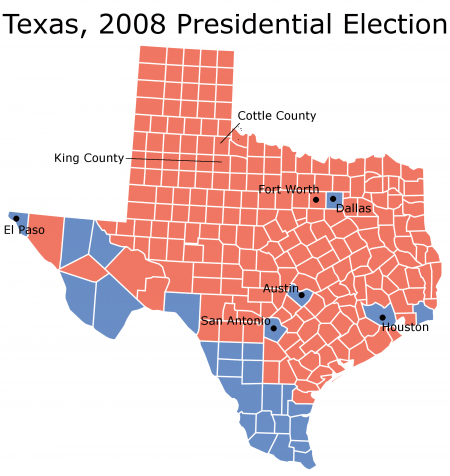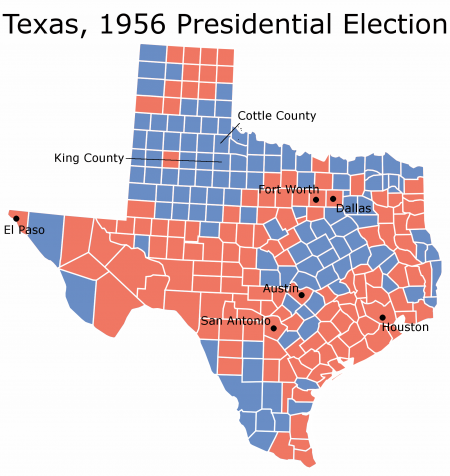• Special elections/Runoffs: Believe it or not, it’s a busy election night tonight. Top of the list is the special election in FL-19, where the successor to Robert Wexler will be chosen. In this D+15 district in the more middle-class parts of the Gold Coast, the Democrat, state Sen. Ted Deutch, is heavily favored. The parties haven’t gotten involved, and Republican Ed Lynch (who lost a lopsided decision to Wexler in 2008) is hamstrung by the presence of independent right-wing candidate Jim McCormick.
It’s runoff day in Texas, with almost all the action on the GOP side. TX-17, between self-funder Bill Flores and 2008 candidate Rob Curnock, and TX-23, between self-funder Quico Canseco and ex-CIA agent William Hurd, are the marquee races as far as the U.S. House goes. There are also some GOP runoffs in some state House races, an interesting mixed bag of open seat succession races, teabaggish challenges to GOP incumbents, and challenges to vulnerable Dems. Finally, there’s a culture war clash between just-very conservative and super-duper conservative in two statewide contests: one for the Supreme Court (with Rick Green, the former state Rep. known for punching the guy who beat him in 2002, representing Team Crazy), and one for the Board of Education (between Marsha Farney and Brian Russell, with Russell the movement conservative here).
Finally, there’s some state legislature action in Massachusetts, California, and Florida. Primaries for two state Senate seats are in Massachusetts, the ones held by now-Sen. Scott Brown and now-disgraced Anthony Gallucio. This is the de facto election in Gallucio’s dark-blue seat, seeing as how no Republicans are running, but the winner between state Rep. Lida Harkins and doctor Peter Smulowitz in the Dem primary will face off against GOP state Rep. Richard Ross on May 11 to succeed Brown. In California, there are two legislative specials; using the California system, each one will likely head to a runoff (unless someone in the cluttered fields breaks 50%). Both seats will likely turn out to be holds: SD-37 is in Republican exurban Riverside County, while AD-43 is in Democratic Glendale in LA County. And in the Florida Panhandle, dark-red HD-04 should be an easy Republican hold.
• AR-Sen: Looks like Blanche Lincoln picked the wrong week to stop acting like a Democrat. She got seriously outraised by Bill Halter in the first quarter, earning $1.3 million (Halter got $2 mil). She also spent more than she earned, running a blitz of TV ads, probably to the tune of $2 million, as her cash on hand dropped $700K –although it’s still a high $4.7 million. Still no word yet from the race’s key Republicans.
• CA-Sen: Carly Fiorina filled in the last blank in the California Senate race; her fundraising total for the first quarter was $1.7 million, edging out Tom Campbell (who pulled in $1.6 million). Both GOPers lagged Barbara Boxer’s $2.4 million.
• FL-Sen: Charlie Crist is still trying to find something that’ll stick to Marco Rubio, and he’s trying again to link ex-state House speaker Rubio to some of the other less savory elements among legislative leadership. He’s up with a new ad trying Rubio to another former speaker, Ray Sansom, who’s currently under indictment for charges of falsifying state budget items.
• IL-Sen: Alexi Giannoulias is lagging Mark Kirk on the cash front; he raised $1.2 million last quarter, compared with Kirk’s $2.2 million. Giannoulias didn’t release cash on hand figures, which may not be too impressive either considering that he had to fight through a competitive primary.
• NC-Sen (pdf): PPP looked at the primaries only in the North Carolina Senate race (they’re on May 4). On the Dem side, former state Sen. Cal Cunningham is still within striking distance of SoS Elaine Marshall; she leads Cunningham 23-17, with Kenneth Lewis at 9 and 5% for assorted minor candidates. (Last month, Marshall led Cunningham and Lewis 20-16-11.) On the GOP side, Richard Burr is at 67%, with his closest competition, Brad Jones, at 7.
• NY-Sen-B, NY-Gov: Quinnipiac finds a lot of same-ol’-same-ol’ in the Empire State: Andrew Cuomo crushing, and Kirsten Gillibrand crushing anyone non-Pataki. Gillibrand trails non-candidate George Pataki 45-40 but leads actual candidate Bruce Blakeman 47-25 (none of the other third-tier GOPers get polled); she’s also sporting her highest-ever approvals, at 47/25. (Pataki beats Blakeman in a GOP primary, 64-15.) On the Governor’s side, Rick Lazio is still poised to be GOP nominee; he leads Steve Levy and Carl Paladino 34-11-11 (note that the poll was in the field prior to the whole bestiality thing). Andrew Cuomo dispatches Lazio 55-26, Levy 57-24, and Paladino 60-24.
• OH-Sen: I’d assumed Lee Fisher had been on the air before, but he’s just now launching his first TV spots of his campaign with the primary only weeks away (apparently marshaling his resources for the general). Fisher also pulled down the endorsement of Cleveland mayor Frank Johnson, although he didn’t gain the backing of his own home town’s Democratic party (in Shaker Heights), which instead declined to endorse.
• PA-Sen: Here’s a bit of a surprise: Joe Sestak succeeded in his ballot challenge, getting last-minute conservadem entrant Joe Vod Varka kicked out of the Democratic primary, setting up a two-man fight against Arlen Specter. If Sestak’s going to have any hope of knocking off Specter, he’ll need to consolidate every anti-Specter vote (and also not have the Slovak-American vote — a big segment in western Pennsylvania — split).
• WI-Sen: Russ Feingold had a successful fundraising quarter, considering right now he’s only running against the specter of Tommy Thompson. Feingold earned $1.34 million, leaving him with $4.26 million CoH.
• FL-Gov: Rick Scott has decided, rather belatedly, to throw his hat in the ring in the Republican field in the Governor’s race. If the name’s familiar, he’s a former hospital-industry businessman who funded much of the initial anti-HCR astroturfing efforts via his organization Conservatives for Patient Rights. He’s sound teabaggish themes about establishment candidate AG Bill McCollum (despite McCollum taking the lead on the GOP AGs’ anti-HCR lawsuit). Considering that state Sen. Paula Dockery is already trying to run against McCollum from the right and getting no traction, it’s hard to see Scott going anywhere with this, though.
• NM-Gov: Lt. Gov. Diane Denish, the lone Dem in the race, is dominating the fundraising front; she raised $1.1 million in the six-month reporting period and has $2.6 million CoH. Among the GOPers, former state party chair Allen Weh leads both in money raised ($691K, although $500K was a personal loan) and CoH ($544K). Dona Ana County DA Susana Martinez raised $428K and sits on $364K CoH.
• PA-Gov: Here’s a blow to, well, everybody in the Democratic field; after not being able to find two-thirds support for anybody, the AFL-CIO won’t be endorsing any particular candidate in the Dem primary. Former Philadephia city controller Jonathan Saidel got their Lt. Gov. endorsement.
• AL-05: Party-switching Rep. Parker Griffith (most recently in the news for forgetting his party-switch and billing the DCCC for expenditures) surprised his GOP primary opponents at a debate by asking them sign a unity pledge that the losers of the primary would campaign for the winner in November. No thanks, said both Mo Brooks and Les Philip.
• DE-AL: Looks like wealthy self-funder Michelle Rollins, the NRCC’s preferred recruit in the race, has some competition on the big bucks front in the GOP primary. Real estate developer Glen Urquhart just announced that he has $512K in his account (of course, $500K of that came from his own pocket).
• FL-08: Alan Grayson had another big fundraising quarter, thanks in large part to netroots moneybombing (especially his March event which brought in $500K). He raised $803K in the last three months, bringing his CoH total to $1.5 million (along with the possibility of writing checks to himself).
• HI-01: CQ has an interesting piece on HI-01 that focuses primarily on just how difficult it is (especially for “mainland” pollsters) to poll in Hawaii. With only two polls of this race having seen light of day so far, the main takeaway may be that anyone’s guess is as good as mine where the race stands.
• MI-01: One of the top Republicans on everyone’s candidate list for the newly-opened seat in MI-01 has said that he won’t run. State House minority leader Kevin Elsenheimer said he won’t run, even though he’s termed out of the House and needs something else to do. (Elsenheimer, from the Traverse City area, is disadvantaged by not coming from the Upper Peninsula portion of the district.)
• MS-04: Here’s one other eye-catching fundraising note: a Dem incumbent who got outraised by Republican opposition previously considered inconsequential. Rep. Gene Taylor raised $41K and has $221K CoH, while GOP state Rep. Steven Palazzo raised $125K and has at least $100K CoH. Let’s hope Taylor doesn’t hit the “snooze” button for another quarter. National Journal’s latest fundraising outline also has noteworthy numbers from Charlie Dent (PA-15), Dan Debicella (CT-04), and Rick Crawford (AR-01).
• Redistricting: With the Fair Districts redistricting initiative seeming destined to make the ballot in Florida, now the Republican-controlled legislature is trying to get its own redistricting initiative on the ballot, in an apparent effort to clarify (or gut) the Fair Districts proposals. The Senate’s proposal deals with the thorny questions of VRA-mandated districts and communities of interest, which aren’t addressed in satisfactory manner by the original initiatives, which forbid designing districts in a manner that is favorable to one party or the other.
• Demographics: Josh Goodman has an interesting look at population change in Texas, similar to some work we’ve done at SSP over the last few years; he finds that while Texas’s largest counties are becoming swingier, its fastest-growing counties are still pretty solidly Republican (although the growth in these counties is in demographics that aren’t likely Republican). Of course, the parts of the state that are becoming less and less of the state, percentage-wise — the rural parts — have become even more conservative than the fast-growing exurbs, so in a way that’s progress too.





